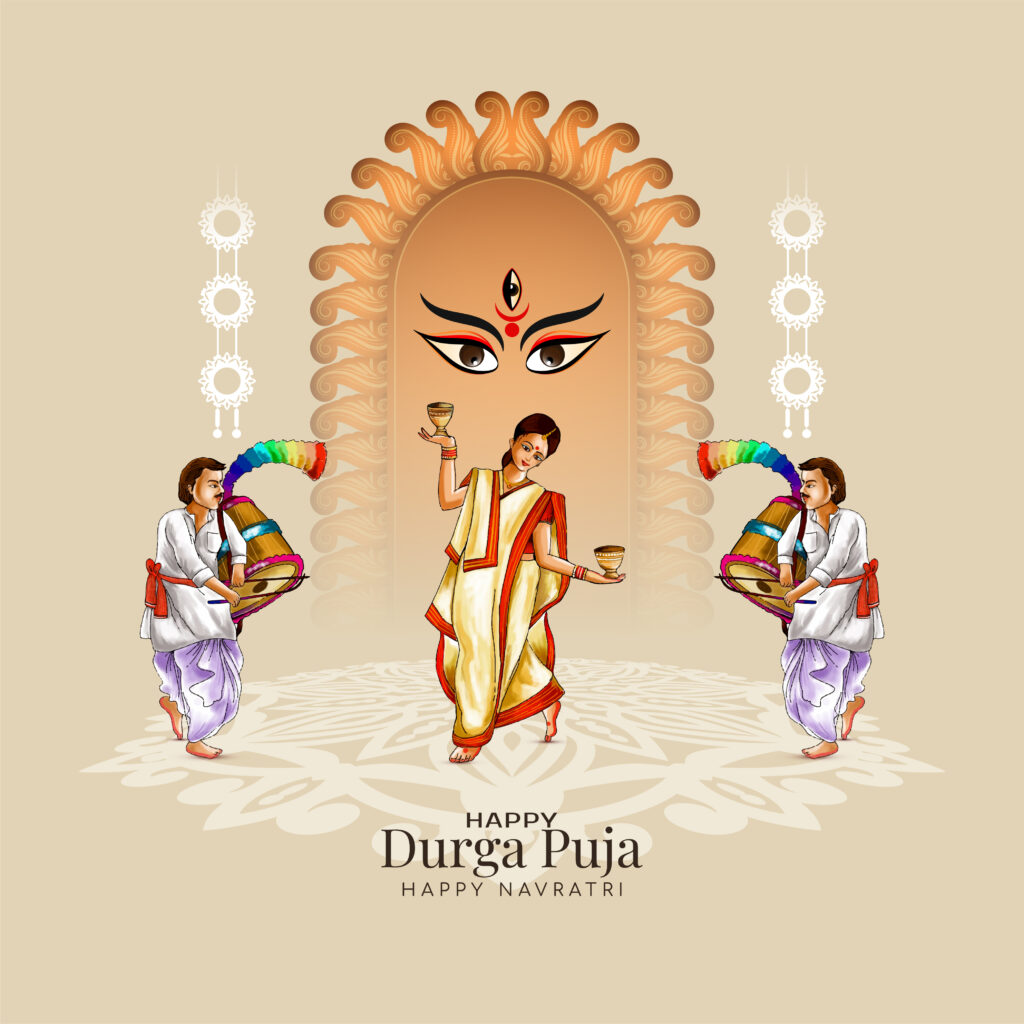Durga Puja is the cultural identity of West Bengal and the Bengali diaspora worldwide. Beyond festivals, it has evolved into a comprehensive creative and commercial ecosystem.
From clay artisans and electricians to event designers, caterers, transporters, advertisers and retail shops, the Puja season generates a concentrated burst of economic activity that sustains tens of thousands of livelihoods every year.
Recent studies and reports now put a number on that scale, showing how governments and brands have learned to harness the festival’s cultural energy for job creation, demand, and branding.
- West Bengal CM Mamata Banerjee inaugurated 3000 major puja pandals for Durga Puja 2025.
- Union Home Minister Shri Amit Shah inaugurated the Durga Puja Pandal while invoking regime change in West Bengal.
A Brief History: Ritual, Theatre, Public Celebration
Durga Puja is rooted in ancient Sanskrit texts (the Devi Mahatmya) and evolved over centuries from family worship to public (“baroyari”) pandals and community orgs in Bengal.
The modern public Puja, with elaborate pandals, themed art, and community fundraising, emerged across the 18th–20th centuries and is now a UNESCO-recognised cultural expression in Kolkata. These cultural layers explain why the festival is both devotional and spectacular.
How Big is the Durga Puja Economy Today?
A detailed mapping of the “creative economy” around Durga Puja estimates the sector’s worth at roughly ₹32,000–₹32,377 crore in West Bengal, equal to a substantial slice of the state economy and reflecting activity across at least ten creative and service sectors (pandal construction, idol-making, illumination, transport, events, retail, food & beverage, tourism, advertising and media).
That study, supported by academic partners and cultural bodies, highlights Puja as one of the world’s most significant public arts events in economic terms.
Who Benefits: the Supply Chain in Quick View
Over 40,000 puja pandals are built across West Bengal during Durga Puja. It generates lakhs of employment opportunities. This cultural and religious extravaganza is expected to create 3 lakh jobs in 2024 and generate significantly more in 2025.
- Artisans and sculptors, including clay modellers, painters and gold-leaf artists, who start work months earlier. Kumartuli in Kolkata is a hub for idol-making, and thousands of artisans from across West Bengal and Jharkhand come here for artisanal and sculptural work.
- Pandal makers, event companies and electricians for temporary infrastructure, lighting and audio-visual teams, and repairs on-site during the 10 days of Durga Puja.
- Local retail & food vendors serving high foot traffic that boosts sales for garment shops, street food, sweets, and seasonal merchandise.
- Media & advertising agencies manage festival ad spends and plan creative campaigns for regional audiences.
- Transport & logistics demand spikes for shoppers, tourists, and pandal hoppers.
Over three crore people visit Durga Puja pandals in Kolkata, and millions more visit them in other parts of West Bengal.
Together, these linkages make Puja a significant seasonal employer and an essential source of income for urban and peri-urban West Bengal. The income generated during Durga Puja accounts for approximately 2 to 3% of West Bengal’s GDP. Therefore, it’s a substantial booster for the state economy of West Bengal.
Government Support & Public Policy Shifts
In recent years, West Bengal has increased direct support to Puja committees and cultural promotion. Grants to puja committees have risen substantially, with the state announcing larger per-committee aid (figure increases reported for 2025) as part of cultural and livelihood support.
It is a commendable move that both recognises Durga Puja‘s economic role and stabilises funding for smaller organisers. Public financing, along with concessions (such as utilities and permissions), helps keep many local pujas viable.
West Bengal CM Mamata Banerjee announced an honorarium of Rs. 1.10 lakh for Durga Puja communities, a hike of almost 30% from Rs. 85,000 in 2024. It will cost the State Exchequer Rs. 495 crore. (Source: The Hindu)
How Brands Use Durga Puja: from Sponsorships to Drone Shows
Brands treat Durga Puja as a premium regional moment for visibility and engagement. In 2025, businesses resumed sponsoring events and on-ground activations across thousands of pandals, a trend reflected in the rise of corporate sponsorship and festival advertising expenditures.
Categories such as FMCG, auto, e-commerce, jewellery and electronics lead the surge in Puja advertising budgets.
- Leading national, regional, and international brands collectively spent between Rs. 500 crore and Rs. 800 crore on promotions and sponsorships in Kolkata during Durga Puja 2023.
- Out of that marketing budget, Rs. 150 crore was spent on street banners and gates.
- Spending is projected to rise by 10 to 15% during Durga Puja 2022, with regional brands allocating up to 30% of their marketing budget to festivals, including Durga Puja itself.

Examples of Modern Brand Activations
- Drone and sky shows: Large consumer brands used drone displays and evening spectacles to attract crowds and create social content tied to Puja nights — an eye-catching fusion of tradition and technology.
- Retail & logistics tie-ups: E-commerce and fashion players expanded express delivery and local fulfilment ahead of Puja to capture last-minute shopping demand.
Brands Plan a Holistic Marketing Campaign Through a 3 Step Process
- Direct sponsorship of pandals and events
- Targeted creative campaigns on TV/digital timed to peak pandal-hopping
- Retail/logistics initiatives to convert festive foot traffic into sales.
The Present & Future: What the Data and Trends Indicate
Current indicators, including a multi-thousand crore creative economy estimate, rising state grants, stronger corporate sponsorship, and a reported 10–15% surge in Puja ad spends, suggest a festival whose commercial footprint is expanding in scale and sophistication.
sponsorships, digital activations and public-private investments keep growing, the creative/experiential economy around Puja will likely see incremental growth (more events, higher ad budgets, deeper retail integration).
That said, local retail outcomes vary by neighbourhood and market dynamics, reporting shows mixed retail performance even when sponsorship rises, so growth is not uniform.
Why This Matters Beyond “Fun and Art.”
- Jobs & livelihoods: months of work for artisans and seasonal labour.
- Cultural tourism: an annual reason for domestic visitors to travel to Kolkata and nearby towns.
- Creative industry growth: festivals like Puja provide real demand for designers, lighting experts and media creators, building longer-term creative capability.
Top Durga Puja Campaigns by Leading Brands in 2024
- Dabur Chyawanprash: Pujo with Dada
- ENO: ENO Chewy Bites
- Simply Fresh: #HarLadkiDurga
- Senco Gold & Diamond: Aparupa Campaign
- Tata Cliq: House of Utsav (Social media campaign)
- Paragon: Pujo Mane Chonmone Mon, Chola Mane-e Paragon
- Marico’s Nihar Naturals: Pujo Ready with Nihar
(Source: MediaNews4U)
Tips for Brands & Policymakers for Durga Puja: The Heartbeat of Every Bengali
Brands: Combine on-ground sponsorship with local offers (such as instant delivery and pop-up experiences) and shareable creative content. Use thematic pandals for narrative alignment.
Policymakers should continue to streamline grants, provide training for artisans, and enhance event infrastructure, as small but consistent investments unlock disproportionate returns in terms of creativity and employment.
Community committees: diversify funding (brand, micro-patronage, and ticketed events) to reduce risk and raise quality.
Conclusion
Durga Puja is more than a festival, it’s an economic engine for Bengal. From artisans to advertisers, brands to local vendors, every sector thrives during this season. With rising government support and corporate investment, Puja continues to power livelihoods, boost GDP, and showcase Bengal’s cultural and creative strength.
Frequently Asked Questions
What is the economic impact of Durga Puja in West Bengal?
Recent estimates suggest a total of roughly ₹32,000–32,377 crore for the creative economy around Puja.
Who benefits most from this spending?
Artisans, pandal builders, food vendors, retail shops, media/advertising agencies and local transport workers.
Are brands spending more on Durga Puja now?
Yes, corporate sponsorship and ad spends have risen in 2025, with FMCG, auto and e-commerce leading the surge.
Does the state help fund Puja committees?
West Bengal has increased per-committee grants and support, with higher totals reported for 2025.
Can brands use Durga Puja for sales, or is it just for branding purposes?
Both. Brands get visibility (branding) and convert footfall into sales with targeted retail offers, express delivery and local promotions. Recent activations (drone shows, express delivery rollouts) show this mix in practice.
About The Author
Biswajit Singh is a passionate writer and researcher specialising in Indian culture, festivals, and creative storytelling. With a background in literature and cultural studies, Biswajit Singh combines traditional and modern perspectives to help readers connect deeply with their heritage. Over the years, he has contributed articles to local newspapers, journals, and digital media on topics relating to Indian festivals, traditions, history, and cultural heritage.

1 thought on “Durga Puja: The Festival that Fuels Bengal’s Economy”